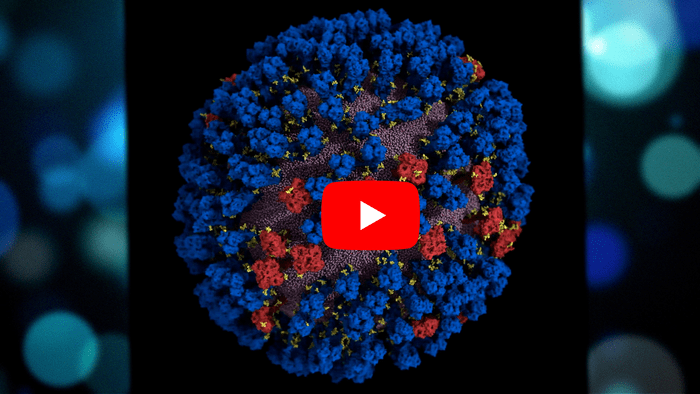The potential “tripledemic” of influenza, SARS-CoV-2 and RSV (respiratory syncytial virus) infection continues to be a concern. Vaccines remain the best defense against COVID-19 and influenza, with the flu vaccine mainly targeting two proteins on the virus’s surface. Now, researchers in ACS Central Science report that simulations show the proteins can tilt and wave in “breath-like” motions, which could be exploited to better defend against the flu. Watch a video of the proteins here.
The flu virus sickens people by sneaking past their immune defenses, entering cells and then replicating. Hundreds of hemagglutinin (HA) and neuraminidase (NA) proteins cover the viral particles, helping the particles get into cells and helping new virions leave. But researchers have a limited understanding of how these proteins move in vivo — information that could assist scientists in developing a universal flu vaccine and more effective antiviral drugs. So, Rommie Amaro and colleagues at the University of California San Diego wanted to simulate the whole influenza A virion and look at the proteins’ movements and interactions for potential weaknesses.
The researchers conducted detailed simulations of the 161 million atoms of the influenza A H1N1 virion, commonly referred to as swine flu, and found that both HA and NA are quite flexible. Here are the details:
- NA proteins have globular heads on top of a thin stalk, and the head can tilt down more than 90 degrees, acting like a weedwhacker on a rotating axis. From these data, the researchers realized that as the head tilts, the underside of the protein becomes accessible to a human monoclonal antibody, NDS.1.
- HA proteins protrudes up from the viral membrane, connected by a flexible hinge, and can also tilt but not quite as much. Interestingly, some of the HA proteins seemed to “breathe” — the top of the protein shifted from a closed position to a partially open structure and back again. In the open state, the protein was accessible to a broadly protective human antibody, FluA-20, suggesting that keeping it in that position could be a way to develop more effective drugs against the flu virus.
Finally, the simulations showed that the HA and NA proteins could clump together with up to five nearby HA and/or NA proteins and then form even larger aggregates involving tens of proteins. By clustering, the two proteins could contend for the same receptors on host cells, potentially affecting the virus’s entry into or exit from cells, the researchers say. They conclude that these first-of-their-kind visualizations show many new vulnerable states of flu viruses, which could improve future vaccines and antiviral drugs.
The authors acknowledge funding from a Visible Molecular Cell Consortium Fellowship, the National Institutes of Health, a National Science Foundation Graduate Research Fellowship, the National Science Foundation, the Intramural Research Program of the Vaccine Research Center, the National Institute of Allergy and Infectious Diseases, the National Institutes of Health, the Frederick National Laboratory for Cancer Research and Leidos Biomedical Research Inc.
The American Chemical Society (ACS) is a nonprofit organization chartered by the U.S. Congress. ACS’ mission is to advance the broader chemistry enterprise and its practitioners for the benefit of Earth and all its people. The Society is a global leader in promoting excellence in science education and providing access to chemistry-related information and research through its multiple research solutions, peer-reviewed journals, scientific conferences, eBooks and weekly news periodical Chemical & Engineering News. ACS journals are among the most cited, most trusted and most read within the scientific literature; however, ACS itself does not conduct chemical research. As a leader in scientific information solutions, its CAS division partners with global innovators to accelerate breakthroughs by curating, connecting and analyzing the world’s scientific knowledge. ACS’ main offices are in Washington, D.C., and Columbus, Ohio.
To automatically receive news releases from the American Chemical Society, contact newsroom@acs.org.
Follow us: Twitter | Facebook | LinkedIn | Instagram
Journal
ACS Central Science
DOI
10.1021/acscentsci.2c00981
Article Title
Breathing and tilting: Mesoscale simulations illuminate influenza glycoprotein vulnerabilities
Article Publication Date
8-Dec-2022









































